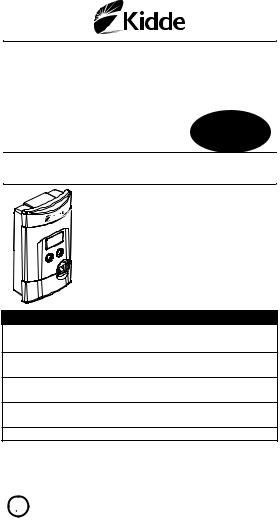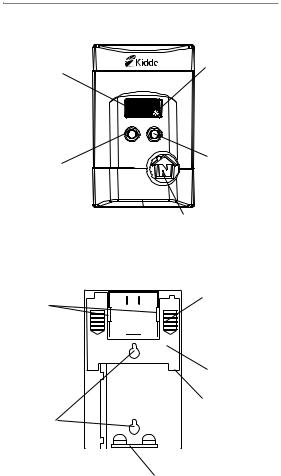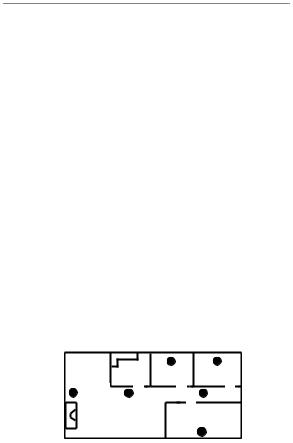Kidde KN-COPP-3 User Manual

Carbon Monoxide
Alarm See page
26 for “What to do when the alarm sounds”
User’s Guide
Kidde CO Alarm with
Digital Display and Peak Level Memory
Model: KN-COPP-3
Please have the following information ready if you are calling customer Service:
CO Alarm Model Number (Located on the back of alarm):
CO Alarm Assembly Number (Located on back of alarm):
Date of Manufacture (Located on back of alarm):
Date of Purchase:
Where Purchased:
Attention: Please take a few minutes to thoroughly read this manual, which should be saved for future reference and passed on to any subsequent owner. If you have any questions about the operation or installation of your alarm, please call our toll free Consumer Hotline at 1-800-880-6788.
SIGNALING
UL
LISTED |
810-0934 |
|
REV D |
||
|

Contents
Introduction
Quick Set Up Guide
Features
Installation
Operation
Maintenance
Technical Information
Limited Warranty
WARNING: THIS CARBON MONOXIDE ALARM IS NOT A SUBSTITUTE FOR INSTALLING AND MAINTAINING AN APPROPRIATE NUMBER OF SMOKE ALARMS IN YOUR HOME. THIS ALARM WILL NOT SENSE SMOKE, FIRE, OR ANY POISONOUS GAS OTHER THAN CARBON MONOXIDE. FOR THIS REASON YOU MUST INSTALL SMOKE ALARMS TO PROVIDE EARLY WARNING OF FIRE AND TO PROTECT YOU AND YOUR FAMILY FROM FIRE AND ITS RELATED HAZARDS.
WARNING: THIS PRODUCT IS INTENDED FOR USE IN ORDINARY INDOOR RESIDENTIAL AREAS. IT IS NOT DESIGNED TO MEASURE COMPLIANCE WITH COMMERCIAL AND INDUSTRIAL STANDARDS. THIS ALARM IS NOT SUITABLE FOR INSTALLATION IN HAZARDOUS LOCATIONS AS DEFINED IN THE NATIONAL ELECTRICAL CODE . INDIVIDUALS WITH MEDICAL PROBLEMS MAY CONSIDER USING WARNING DEVICES WHICH PROVIDE AUDIBLE AND VISUAL SIGNALS FOR CARBON MONOXIDE CONCENTRATIONS UNDER 30 PPM.
IMPORTANT: THIS CARBON MONOXIDE ALARM IS DESIGNED TO DETECT CARBON MONOXIDE FROM ANY SOURCE OF IMPROPER OR MALFUNCTIONING APPLIANCES. THE INSTALLATION OF THIS DEVICE SHOULD NOT BE USED AS A SUBSTITUTE FOR PROPER INSTALLATION, USE AND MAINTENANCE OF FUEL BURNING APPLIANCES INCLUDING APPROPRIATE VENTILATION AND EXHAUST SYSTEMS
WARNING: THIS ALARM WILL NOT WORK WITHOUT POWER. THIS ALARM REQUIRES A CONTINUOUS SUPPLY OF POWER.
WARNING: THIS UNIT IS NOT A SMOKE ALARM. IT WILL NOT SENSE SMOKE OR FIRE. FOR EARLY WARNING OF FIRE YOU MUST INSTALL SMOKE ALARMS, EVEN THOUGH CARBON MONOXIDE CAN BE GENERATED BY FIRE.
Thank you for the purchase of your new Kidde carbon monoxide alarm. If you have any questions about the operation or setup of your CO alarm, feel free to call our Consumer Hotline at 1-800-880-6788.
2

Introduction
This Kidde carbon monoxide (CO) alarm is an important part of your family’s home safety plan. As a new owner of a CO alarm, there are some basic facts you should know for your protection and convenience.
Many people think that CO alarms operate like smoke alarms. Like smoke alarms, CO alarms monitor the air in your home and sound a loud alarm to warn you of trouble.
The way you respond to a CO alarm is quite different than a smoke alarm. That’s because a house fire and a carbon monoxide problem are two distinctly different situations. If your smoke alarm were to alarm, you would quickly be able to judge the level of danger you were in with your senses. You can see and smell the smoke, feel the heat, see, and possibly hear the fire burning. You can also readily see if your smoke alarm is alarming in a non-emergency situation, for example someone smoked up the kitchen with some burnt toast. Because your sense of sight, smell, hearing and touch give you information, you can almost instantly judge what action to take if you hear your smoke alarm.
Carbon monoxide (CO) is invisible, odorless, tasteless, non-irritating, poisonous gas that is completely undetectable to your senses. It is created when any fuel is burned – gasoline, propane, natural gas, oil, wood, coal, and even tobacco. When oxygen is limited during combustion, more CO is produced. Serious problems can develop when combustion by-products are not properly vented outside the house. That’s why it’s so important to your safety that you have a carbon monoxide alarm.
Please take the time to completely read this guide to familiarize yourself with the facts about carbon monoxide, how your new unit works, and what to do if it alarms. Find a handy place to keep this manual so that it will be readily available when you have a question.
Thank you for making Kidde a part of your complete home safety program. With proper installation and use, your new Kidde CO alarm will provide you with years of dependable service.
3

Quick Set Up Guide
We urge you to read this entire guide in the sequence it is presented. If you only read one part of this guide initially, read the following two pages!
Listed below are seven easy steps for setting up your Kidde CO alarm. Please read the entire guide for complete information.
Setting up your alarm for first time operation:
Step 1
Determine the best location for your CO alarm(s). Usually this is in or near bedrooms. Refer to page 10 for complete information.
Step 2
Your CO alarm is equipped to be mounted as a corded unit, a direct plug unit or a table top unit. In the “as shipped” configuration, the unit can be plugged directly into a wall socket. (If your outlets are mounted horizontally, please refer to page 13, “to rotate adapter”). If the transformer/adapter is taken out of the unit, the alarm can be mounted on the wall at eye level, while the transformer is plugged into a wall socket. The unit can also be set on a table if the support at the bottom of the unit is pulled out (see “rear view” illustration on page 6). Refer to page 10 for information on installing your alarm.
Step 3
A 9V battery is needed for backup in the event of a power outage. When installing the battery, use an Energizer 522, Duracell MN 1604 or, for extended life, use an Ultralife lithium power cell model U9VL. Any of these batteries can be purchased where you bought the alarm or at your local hardware store. To install the battery, open the back door and snap battery connector onto battery. You will hear the alarm sound briefly to indicate the unit is receiving power. Place battery into battery compartment and replace back door. Refer to page 13 for information to remove the back door.
Step 4
Plug the alarm into a standard, unswitched 120 volt AC electric outlet in one of the configurations listed in step 2. Refer to page 6 for more details.
4

Quick Set Up Guide
Step 5
You will either see a flashing red dot or you will see three eights  in the digital display indicating the alarm is warming up. After approximately 20 seconds, the first reading will appear on the digital display. The number on the digital display should be zero (0). If not, see page 15 for complete information on normal operating characteristics.
in the digital display indicating the alarm is warming up. After approximately 20 seconds, the first reading will appear on the digital display. The number on the digital display should be zero (0). If not, see page 15 for complete information on normal operating characteristics.
Step 6
Make sure the red dot in the digital display is blinking. Then test the unit’s operation by pressing and releasing the Test/ Reset button. Within 15 seconds you will hear 4 quick “chirps” -followed by 5 seconds of silencefollowed by 4 quick “chirps”. For complete testing information, refer to page 16.
Step 7
While testing the alarm, have someone else check that the alarm can be heard easily from the sleeping areas. The alarm should be located where it can wake you if it alarms at night. Caution: Continuous exposure to the loud 85 decibel alarm at close range over an extended period of time may cause hearing loss.
Your Kidde CO alarm is now monitoring for the presence of carbon monoxide.
5

Features
Digital
Display
Test/Reset
Button
Adapter
Thumb
Release
Kidde CO Alarm – front view
Blinking
Red Dot
Peak Level
Button
Alarm
Sounder
Kidde CO Alarm – rear view
Thumb Grip for Back Door Removal (Slide Down)


 Removable
Removable
Adapter
Back Door
Door “Latches” at all four
Key Holes corners of back door
Slide Support for Table
Top and Direct Plug Use
6

Features
Rear view with back door removed
|
9V Backup Battery |
|
|
(Shown installed) |
|
Cord |
|
|
Recess |
Battery |
|
|
||
|
Connector |
|
Power |
|
|
Cord |
|
|
Adapter Cord |
Install Backup |
|
Strain Relief |
||
Battery |
||
|
||
|
as shown |
Note: Your Kidde CO alarm is NOT battery operated.
The backup battery is to supply short-term backup power during a power outage. In the event of a power outage, the battery will continue operating the alarm for at least 20 hours.
The Unique Features of this Kidde CO Alarm
Digital Display
Thecontinuousdigitaldisplayshowsyouthelevelofcarbonmonoxide(ifany)theunit is sensing. The unit updates the digital display every 15 seconds .
Note: If the unit reading is zero (0), then 30 ppm or less of CO has been sensed by the alarm within the last 15 seconds.
Test/Reset Button
The Test/Reset button has three functions:
1.Press this button to test the unit weekly (see page 16 for further details).
2.Press this button if the unit alarms to silence the alarm. This will reset the unit and it will then start monitoring for CO. If the CO concentration is above 70 ppm the alarm will again sound within 6 minutes.
3.Press the Test/Reset button to reset peak level memory. (See page
19).
7

Features
Peak Level Button
By pressing this button, you can see the peak CO level recorded by the alarm since it was last cleared or unplugged. This Kidde feature allows you (or a heating contractor or a fireman) to see exactly how serious the CO problem you have so you can react accordingly.
Sensor
The sensor is a highly sensitive, electrochemical sensor that is CO-specif- ic to help avoid false alarms.
Sounder Alarm
This is the loud 85 decibel pulsing alarm that will sound to alert you to a potential problem. An alarm condition is 4 quick “chirps” – followed by 5 seconds of silence – followed by 4 quick “chirps”. This pattern repeats until the alarm is silenced or a high level of CO is no longer present.
Caution: Continuous exposure to this sound level at close range over an extended period of time may cause hearing loss. We recommend you cover the sounder with your finger or thumb while testing the alarm.
Keyholes
When the alarm is mounted to the wall, the keyholes slide onto the screws mounted in the wall.
Pull-Out Transformer/Adapter
This unique Kidde feature enables the alarm to be used as a direct plug unit, a wall mounted unit or a table top unit.
9 Volt Back-up Battery
Note: This CO alarm is not battery operated.
The 9 volt battery supplies short term backup power during power outages
8

Features
What Carbon Monoxide Alarms Can and Cannot Do
CO alarms are designed to sense unacceptable levels of CO from malfunctioning furnaces, appliances, gas engines or other sources. This Carbon Monoxide alarm is not a substitute for installing and maintaining an operational smoke alarm.
CO alarms provide early warning of the presence of carbon monoxide, usually before a healthy adult would experience symptoms.
This early warning is possible, however, only if your Kidde CO alarm is located, installed and maintained as described in this user’s guide.
This CO alarm is designed to act as a monitor, it is not designed for use as a short-term testing device to perform a quick check for the presence of CO.
CO alarms have limitations. Like any other electronic device, CO alarms are not fool-proof.
CO alarms have a limited operational life. You must test your CO alarm weekly, because it could fail to operate at any time. If your CO alarm fails to test properly, or if its self-diagnostic test reveals a malfunction, immediately have the unit replaced. See back page for warranty information. This CO alarm also has an "operational end of life" feature which will indicate when to replace the alarm. See page 28 for details of this feature.
CO alarms can only sense CO that reaches the unit’s sensor. Carbon monoxide may be present in other areas without reaching the alarm. The rate at which CO reaches the unit may be affected by doors or other obstructions. In addition, fresh air from a vent or open window or any other source may prevent CO from reaching the sensor. Please observe cautions on page 5 “Where to install your alarm.”
CO could be present on one level of the home and not reach a CO alarm installed on a different level. For example, CO in the basement may not reach an alarm on the second level, near the bedrooms. For this reason, we recommend you provide complete coverage by placing a CO alarm on every level of the home.
CO alarms should not be used to detect the presence of natural gas (methane), propane, butane, or other combustible fuels.
CO alarms are not a substitute for property, disability, life or other insurance of any kind. Appropriate insurance coverage is your responsibility. Consult your insurance agent.
9

Installation Instructions
Where to Install Your CO Alarm
Your Kidde CO alarm should be mounted in or near bedrooms and living areas. It is recommended that you install a Kidde CO alarm on each level of a multi-level home. You may use the number and location of smoke alarms installed in your home according to current building code requirements as a guide to the location of your Kidde CO alarm(s).
WHEN CHOOSING YOUR INSTALLATION LOCATIONS, MAKE SURE YOU CAN HEAR THE ALARM FROM ALL SLEEPING AREAS. IF YOU INSTALL ONLY ONE CARBON MONOXIDE ALARM IN YOUR HOME, INSTALL THE ALARM NEAR BEDROOMS, NOT IN THE BASEMENT OR FURNACE ROOM.
Two labels have been provided with important information on what to do in case of an alarm. Add the phone number of your emergency service provider in the space provided. Place one label next to the alarm after it is mounted, and one label near a fresh air source such as a door or window.
CAUTION: This alarm will only indicate the presence of carbon monoxide at the sensor. Carbon monoxide may be present in other areas.
IMPORTANT: Improper location can affect the sensitive electronic components in this alarm. Please see the next section describing where NOT to install this alarm.
•Insure that all vents of the unit are unobstructed.
•For tabletop mounting we recommend the unit be placed no higher than three feet from the floor.
Recommended Locations
DINING KITCHEN BEDROOM BEDROOM
LIVING ROOM BEDROOM
Upper Levels of the Home
10
